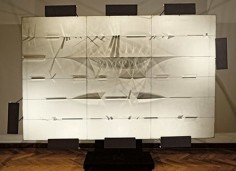hermann goepfert
optophonium
source: kettererkunst
The sculptor, painter and object artist Hermann Goepfert is an important representative of Kinetic Art and post-war abstraction.
Hermann Goepfert was born in Bad Nauheim in 1926. His adolescence fell into World War II, so Hermann Goepfert could not begin his education as artist before 1947, then he took evening courses with Theo Garvé at the Frankfurt Städelschule. Between 1951 and 1958 Hermann Goepfert also studied in Frankfurt, in the end as master student of Albert Burkart and from 1955 on as scholarship holder of the Studienstiftung des Deutschen Volkes (German National Academic Foundation ).
In those years Hermann Goepfert created early figurative works that stood in the tradition of Oskar Schlemmer, Max Beckmann and Fernand Léger. In the late 1950s Hermann Goepfert gradually approached abstraction. He soon attained monochrome, expressive works such as the “Rot-Bilder” (Red Pictures) and the “Schwarz-Bilder” (Black Pictures). In 1958 Hermann Goepfert, Klaus Franck (a gallery owner), the art theorist William Simmat and the artist colleagues Heinz Kreutz, Borris Goetz and Christian Kruck founded the “Frankfurter Gruppe”.
In the 1960s and 1970s Hermann Goepfert also taught at Kunsthochschule Kassel and the Städelschule in Frankfurt am Main. In the second half of the 1960s Hermann Goepfert spent more and more time in Antwerp and eventually settled there for good in 1971.
In the 1960s and 1970s Hermann Goepfert’s art was similar to that of the group ZERO (Heinz Mack, Otto Piene and Günther Uecker). White and light shades of gray were predominant; light, sound and motion were integrated into the works. The “Reflektor-Bilder” with mobile metal-plates play with light and shade in a subtle manner.
Works by Hermann Goepfert are part of permanent exhibitions in many museums, for instance the Musées royaux des Beaux-Arts de Belgique in Brussels or the Frankfurt Städel.
In 1982 Hermann Goepfert died in Antwerp.
.
.
.
.
.
.
.
source: dierkingch
HERMANN GOEPFERT (1926 – 1982)
Hermann Goepfert, who worked mainly in Frankfurt am Main, is considered the most important representative of the ZERO movement. Having completed his studies at the Städelschule he turned to non-objective painting. His monochrome „white pictures“, painted as from 1960, attracted great interest. International artists came to the city on the river Main in the 1960ies, in order to exchange ideas with Goepfert or to work with him. Amongst his artist friends were Lucio Fontana, Piero Manzoni and Jef Verheyen.
From the beginning of the 1960ies he took part in important presentations around the ZERO group, such as in the exhibition „NUL“ at the Stedelijk Museum in Amsterdam or the documenta III in Kassel. Both in Kassel and at the subsequent international ZERO exhibitions he presented „aluminium reflectors “. Goepfert was mainly occupied with natural light as visual material and experimented with metals, which due to their smooth surface reflect light better than canvas. With the aim to increase the integration of space, he successively replaced canvas by metal.
In 1965, Goepfert formed a “ planning partnership for new forms of environment” ( Planungsgemeinschaft für neue Formen der Umwelt) with architect Johannes Peter Hölzinger in order to put his creative ideas into architectural practice. An early example of the integration of art and architecture within the ZERO movement are the objects and object architectures erected by the partnership in 1965-1967 in the Schlosspark in Karlsruhe for the national horticultural show (Bundesgartenschau).
In 1967 the Palais des Beaux Arts in Brüssel dedicated an individual exhibition to him where he showed static and kinetic works created after the „White pictures“. Here also the focus was on the artistic handling of light.
Ever since his early death – Goepfert died suddenly in Antwerp in 1982 – his works have been shown in the ZERO context. In 1987 a retrospective entitled „Goepfert and ZERO – ZERO and Goepfert“ took place at the Frankfurter Kunstverein. Some of his works will also be shown at the big ZERO exhibition scheduled by the Guggenheim Museum New York in cooperation with the ZERO Foundation, Düsseldorf and the Stedelijk Museum, Amsterdam for autumn 2014.


